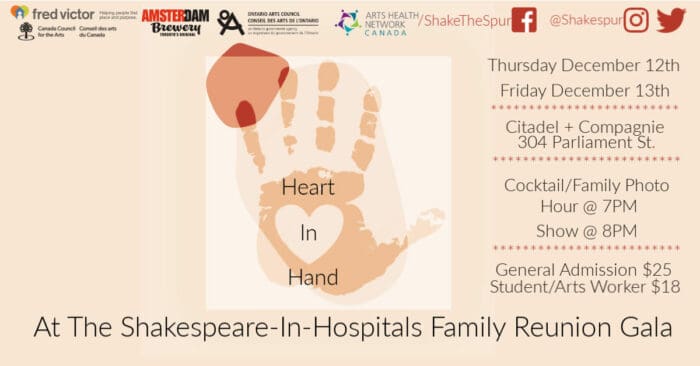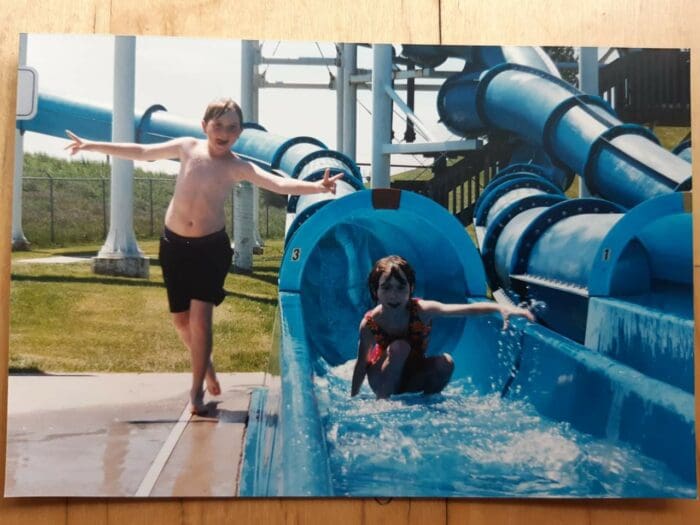
Spur-of-the-Moment Shakespeare Collective’s annual Shakespeare in Hospitals gala is coming up very soon so we caught up with Artistic Director Victoria Urquhart to find out how this season’s show came to be, why the program is as crucial as ever, and how we can get in on the gala festivities.
For anyone unfamiliar with the program, give us the quick pitch for Shakespeare in Hospitals.
This program tours scenes and monologues to various different hospitals, hospices, senior residences and shelters across Toronto and the G.T.A.. It uses a mass amount of Shakespearean text, combined with modern poetry and some of our own writing to tell a new narrative of some identities that Shakespeare didn’t write for in his time, while still giving a taste of some of his most famous lines.
This year my brain made a story up of a mother’s hopeful re-imagining of what will happen to her family when she is gone. It’s funny and sad, touching and calming, reminding us of the fifty different families and networks we have. All in all, it takes a microscope to family dynamics and asks us what we form our families off of.
Tell us about the team you’ve assembled this year.
We’re blessed with a combination of returning and new faces this year. Our directing team has all worked on the project before and have brought this story to life:
Andrew Joseph Richardson from 2014
Eli Ham from 2017
Ara Glenn-Johanson from 2018
Returning faces in our ensemble this year:
Kate McArthur (from 2015) plays Dionyza and the embodiment of Hope
Andrea Massoud (from 2014) plays Leonine
Chanakya Mukherjee (from 2018) plays Apemantus
Our new faces joining us this year in the ensemble:
Andrea Irwin plays Mom (or Philemon)
Nicole Smieja plays Marina
Qianna Macgilchrist plays Timon
This year’s theme is family. How did that concept come about?
So, two years ago I wrote a grant for the program going “yeah, if I had a million bucks, what would I create?”
Out of that came this 3-year project of 3 different shows, each combatting that loss of self we feel when we become a patient. These 3 shows explore three different pillars that we can build our identities off of, giving us a chance to remember, rebuild, reclaim who we are. They are built off of 3 solid questions we have to ask ourselves at different points in our lives as we grow:
How do we decide on Home?
How do we decide on Family?
How do we choose to remember Love?
Let me take you back a bit. My experience with hospitals is not great (but then again most people try to avoid going to the hospital). Neither is my relationship to family (and I swear some days I could openly weep about that at almost any moment).
Hospitals, for me, growing up were either a place of death or a place of being broken. I went there when I was sick, and would wait, or get shamed, or be stuck waiting for others while not understanding all of what was going on, or not understanding why I was sad. It was often where childhood and adulthood collided- where adults would have to dig deep in their adultness to get kids to understand what they felt were adult concepts, and as a kid I could see people struggling and not know why. As I grew older, it became a threat. My mother had a lot of struggles with her mental health when I was growing up, so she had some visits to the hospital with little context for my brother and I (Dad told us Mom broke her nose and had to get it fixed).
Family, for me, for a long time, was not something you could choose. It was something you were born into, and had to love and smile and be pleasant about until your teeth bleed. It honestly wasn’t until recently that I could even consider family to be something or someone that I could choose. Even still, I don’t think I have chosen who my family is. I do however think that my family is not one that I was born into.
I think that my family– my closest family– is one that I have grown into, and has grown into me by the moments that we have shared together.
We didn’t choose to share these moments together, so we didn’t choose each other.
But we did and continue to share these moments which have made us so inseparable over space and time.
That question of “How do you choose your family?” Was a big part of writing the script. As we developed the piece in rehearsal, we built this qualifier to the story, a continuation of that question, which was “How do you choose your family when your family doesn’t choose you?”
…I am still a baby Canadian playwright, so, like, is anyone surprised that there’s a dark suffery twist in there? But it’s got some comedy in there, I swear!
You construct the performance text yourself. Give us a glimpse into that process.
In terms of the performance itself, it’s a lot of work. Working with 3 directors and being a curator on the project means that all of the arcs need to align, and that’s a big challenge. It’s a form of collaboration that I have only seen in a few other places.
We talk a lot about curators in the sense of curating festivals or individual pieces with a theme, not a whole story. It’s been my job to sew it all together and negotiate the clearest, cleanest story possible–Which is not easy with a new work to begin with. We have been tremendously blessed with artists who have stuck it out for all of the conversations and details, every detour, every contradiction, every interpretation that affects another 5 interactions down the road.
In terms of the writing process…
BUCKLE UP FRIENDOS IT’S ABOUT TO GET REAL NERDY & CLICHED-NONSENSICAL IN HERE
STEP 1: brain dump a bunch of related and non-related bard and non-bard text (in two separate files OH GOD PLEASE in two separate files)
STEP 2: pick some characters or relationship texts that you really wanna mash together (this one started with Leonine, Hubert and Celia.)
STEP 3: find a combination of scenes that really connect and build a neat little arc for that character.
STEP 4: Locate the loose ends.
STEP 5: Stare at the blank page for too many hours with too many cups of caffeine or jars of pickles
STEP 6: Cry.
STEP 7: Throw that arc away.
STEP 8: Repeat.
STEP 9: Repeat.
STEP 10: Repeat.
STEP 11: Cry (for good measure).
STEP 12: Throw in some modern text so you can start to reshape and get the hell away from the ridiculous number of mentions of your theme in the way Shakespeare meant it (family does not just mean bloodline or bloodright, BILL.)
STEP 13: Wish that you started exploring the modern text earlier.
STEP 14: Start writing some of your own stuff.
STEP 15: Realize that this is a pastiche play and that outside of your own monologues you have really never written dialogue before and feel like an awkward baby that’s learning to do an artistry that so many more people know how to do it way better than you do and how did you get into this and oh God this sentence is too long and what are you doing with your life and this got way too ethereal way too fast and where were we?
STEP 16: pray to the theater gods
STEP 17: find draft 1.
…
STEP 18: Cry.
STEP 19: Start sewing more loose ends together.
STEP 20: Cry.
Repeat until first day of production.
Which plays did you draw from this year and how do they fit into this all-new narrative?
Oh lord…
Pericles
King John
Twelfth Night
As You Like It
The Merry Wives Of Windsor
Sonnets (many)
R&J
Hamlet
Timon Of Athens
King Henry…pretty much a line from each of them….
Richard iii
Othello
Julius Caesar
The Passionate Pilgrim (Okay, bear with me here)
The Winter’s Tale
Cymbeline
Two Noble Kinsmen
The Tempest
I think that this is mainly the skeleton? There’s a ton more in there with one liners and small bonding texts to soften or better manipulate moments into what we are looking to say.
Leonine and Marina were definitely the first two characters I built through this. Mom kind of pushed her way in, but was a real breath of fresh air when it happened. From there, Timon and Apemantus were the hardest to construct and reconstruct, partially because so much of their original text was already being turned on its head. Hope was last. Hope didn’t come in until the end of draft 1 (which seemed fitting and also what the hell was I doing– but these actors made it work, effortlessly.)
Add on top of that texts from Maya Angelou, Sara Kay and Emily Dickinson and we really soften up and change how Shakespeare defined family.
Also I have some of my own text in there.
Tell us about the gala where the general public can see the performance for themselves.
Come to our Family Reunion Gala where we celebrate and close out our season with a performance of this year’s Shakespeare-In-Hospitals Program’s new piece, Heart In Hand!
Thursday December 12th
And Friday December 13th
Cocktails, Stories and Awkward Family Photo hour at 7pm,
Show at 8pm.
There will be a cash bar, along with a family tree to stick your own photos on (complete with silly photobooth).
Tickets can be bought HERE.
What else do we need to know?
For our Awkward Family Photo Hour, we are actually calling for photos, stories and sayings relating how folks across Canada define family. It’s sort of our own Human Family Photo Album. We are asking folks to send their submissions to our email shakespur@gmail.com. Submissions can be as personal or abstract, silly or meaningful, real or imaginary as you like. Submissions can also be anonymous as requested. Submissions will be respectfully deleted after the gala.
Also here is a ridiculous picture of me at age 7 with my brother:

